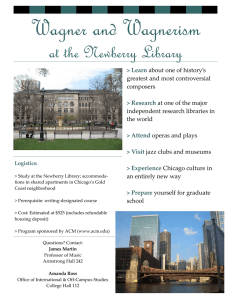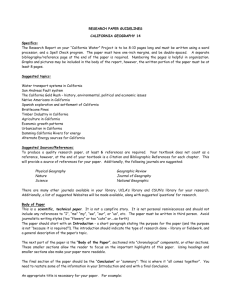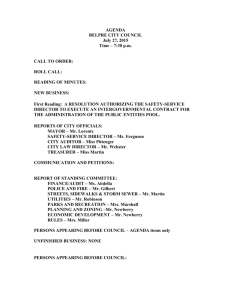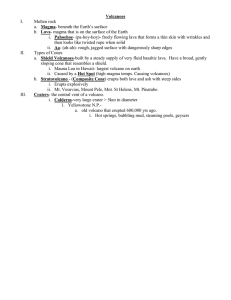Spring 2011 ES407 Senior Seminar New Approaches to Geomorphic Analysis of
advertisement
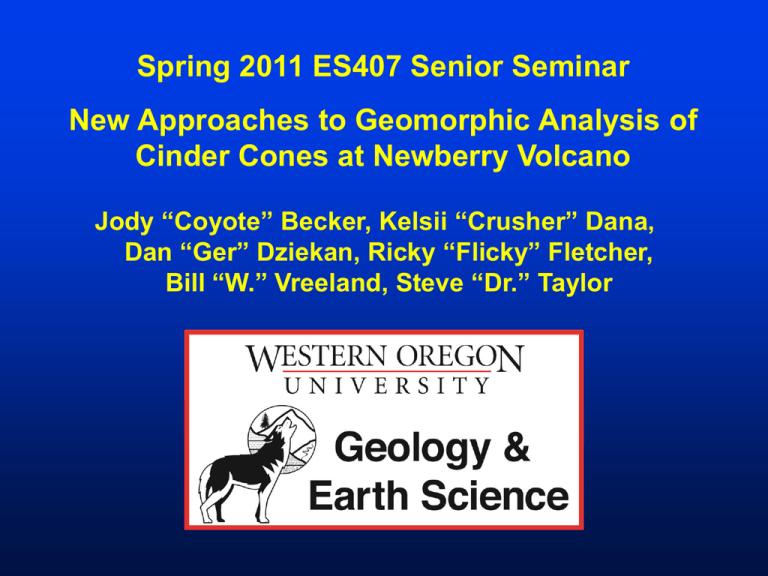
Spring 2011 ES407 Senior Seminar New Approaches to Geomorphic Analysis of Cinder Cones at Newberry Volcano Jody “Coyote” Becker, Kelsii “Crusher” Dana, Dan “Ger” Dziekan, Ricky “Flicky” Fletcher, Bill “W.” Vreeland, Steve “Dr.” Taylor • Introduction (Taylor) • Physiographic Setting (Fletcher) • Tectonic Setting (Vreeland & Dziekan) • Geologic History (Becker & Dana) • The “Cinder Cone Problem” / Previous Work (Taylor) • Cinder Cone Methodology Cone Age-Morphology Concept (Fletcher & Dziekan) Structural Cone Emplacement (Becker) Cinder Cone Alignment (Vreeland) Lidar-Based Elevation Models (Dana) • New Research / Pilot Testing with LIDAR Data Cinder Cone Drainage Density vs. Age (Becker) Modified Two-Point Analysis (Vreeland) Newberry Glacial Hypothesis (Fletcher) Lava Flow Margin Mapping with Lidar (Dana) • Summary and Future Research (Taylor) INTRODUCTION Steve Taylor Cascade Volcanic Arc Linear chain of volcanoes extending from southern British Columbia through Washington and Oregon into northern California WOU Bend Newberry Volcano • 56 km east of Cascade Crest • 40 km south of Bend, Oregon History of Newberry Work at Western Oregon University 2000-Present WOU Class Field Trips and Contextual Learning Modules 2000 Friends of the Pleistocene Field Trip to Newberry Volcano 2002-2003 GIS Compilation and Digitization of Newberry Geologic Map (after MacLeod and others, 1995) 2003 Giles and others, Digital Geologic Map (GSA Fall Meeting) 2003 Taylor and others, Cinder Cone Volume and Morphometric Analysis I (GSA Fall Meeting) 2005 Taylor and others, Spatial Analysis of Cinder Cone Distribution II (GSA Fall Meeting) 2007 Taylor and others, Synthesis of Cinder Cone Morphometric and Spatial Analyses (GSA Cordilleran Section Meeting) 2001-Present Templeton, Petrology and Volcanology of Pleistocene Ashflow Tuffs (GSA Cordilleran Section Meeting 2004; Oregon Academy of Science, 2007; Am. Geophys. Union, 2010) 2010-2011 Newberry LIDAR Elevation Data Available; ES407 Senior Seminar Pilot Tests Next Generation Research Strategies on Cinder Cones; Updated Literature Review PHYSIOGRAPHIC SETTING Rick Fletcher 124 W 120 W 122 W 118 W MJ Cascades Cascades MH Deschutes-Umatilla Plateau Blue Mountains TFZ Coast Western MW TS 1 High Cascadia 44 N Subduction Zone Range 4.5 cm /yr Willa mett e Va lley 46 N WRFZ BFZ High Lava Plains 5 6 CL 7 Klamath Mountains 8 Owyhee Upland 9 10 Basin and Range 42 N 0 Extent of Newberry Lava Flows Newberry Caldera Rhyolite Isochrons (Ma) Faults: TFZ = Tumalo Fault Zone WRFZ = Walker Rim Fault Zone BFZ = Brother Fault Zone 100 km 9 Newberry Volcano, South View from Lava Butte Lookout Caldera Summit Basaltic Aa Lava Flow from Lava Butte; ~7000 yrs BP Newberry Volcano, View to S-SE from Paulina Peak Lookout High Lava Plains Fort Rock (Tuff Ring) Newberry Cinder Cones Basin and Range Newberry Volcano, View to West towards High Cascades from Paulina Peak Lookout South Sister Broken Top Middle Sister Newberry Volcano, View into Summit Caldera from Paulina Peak Paulina Lake East Lake TECTONIC SETTING Dan Dziekan and Bill Vreeland Arc Volcanoes related to Cascadia Subduction Zone Juan de Fuca plate thrust beneath North American plate Magma Source in Subduction Zone Back Arc Fore Arc 35 – 7 Ma 7 – 0 Ma Newberry Position Eastward Arc Migration Decreasing Slab Dip Current Crustal Deformation Rates and Directions Newberry Meigs et al., 2009 Basin and Range Stretching GEOLOGIC HISTORY Jody Becker and Kelsii Dana Overview of Newberry Volcano •Shield-shaped composite volcano •N-S orientation, 64 km x 40 km •Total Area > 1300 km2 •Summit Caldera Area = 44 km2 •Elevation: 1300 m – 2400 m; Relief ~1100 m •Composition: Basalt to Rhyolite •Estimated Volume = 460 km3 •>400 cinder cones and fissure vents •Quaternary in Age Less than ~500,000 yrs old Holocene activity: 10,000 – 1200 yrs BP •One of largest U.S. Quaternary volcanoes •Historic Annual Precipitation: 30 in/yr East flank rain shadow of Cascades Regional Geology • Oregon-Idaho: Paleozoic-Mesozoic oceanic volcanic arcs Accretionary complexes Basinal successions • Cenozoic volcanism: Ignimbrite sweep Flood basalts Bimodal (modern) High Lava Plains Snake River Plain Regional Volcanism • Two migrating tracks: NE along Snake River Plain toward Yellowstone WNW along High Lava Plains (Newberry) • Indicated link between High Lava Plains and Cascades volcanism: Increased output Isotopic similarities Merging structures 122W 120W Extent of Newberry lava flows Rhyolite isochrons ( Ma) 0 100 TFZ km Newberry Caldera Fault Zones: HLP 44N BFZ=Brothers TFZ = Tumalo WRFZ=Walker Rim BFZ CR 1 WRFZ 5 BR 6 7 1 6 9 10 8 Geology after Walker and MacLeod (1991); Isochrons in 1 m.y. increments (after MacLeod and others, 1976) Central Pumice Cone 7200 yrs BP East Lake Big Obsidian Flow 1250 yrs BP STATEMENT OF THE PROBLEM GEOMORPHIC ANALYSIS OF CINDER CONES Steve Taylor Basalt and basaltic andesite flows: early Pleistocene to Holocene Cinder Cone Research Questions Rhyolite to dacite domes, flows, pumice rings, and vent complexes: early Pleistocene to Holocene Pumice falls, ash flows, and alluvial deposits: Pleistocene to Holocene Are there morphologic groupings of ~400 cinder cones at Newberry? Can they be quantitatively documented? Andesite Tuff (west flank): Pleistocene Black Lapilli Tuff (west flank): Pleistocene Alluvial deposits with interbedded lapilli tuff, ash flow tuff, and pumice fall deposits: Pleistocene Are morphologic groupings associated with age and state of erosional degradation? Tepee Draw Tuff (east flank): Pleistocene Basalt and basaltic andesite of small shields: Pleistocene Fluvial and lacustrine sediments: Pleistocene and Pliocene(?) Are there spatial patterns associated with the frequency, occurrence, and volume of cinder cones? Basalt, basaltic andesite, and andesite flows, ash flow tuffs, and pumice deposits of the Cascade Range: Pleistocene Basalt flows and interbedded cinders and scoria deposits: late Miocene Rhyolite and andesite flows, domes, and pyroclastic rocks of Pine Mountain: early Miocene Are there spatial alignment patterns? Can they be statistically documented? Newberry Caldera complex Cinder cones and fissure vents Faults Do regional stress fields and fault mechanics control the emplacement Study AreaNewberry volcano? of 0cinder cones at 5 km Oregon Lava Butte Cone and Aa Flow ~7000 yrs BP (post-Mazama) Ash & Pumice Southeast Cinder Cone Field Existing Methodology Digital Geologic Map Compilation / GIS of Newberry Volcano (after McLeod and others, 1995) GIS analysis of USGS 10-m DEMs Phase 1 Single Cones/Vents (n = 182) Phase 2 Composite Cones/Vents (n = 165) Morphometric analyses Cone Relief, Slope, Height/Width Ratio Morphometric Classification Volumetric Analyses Cone Volume Modeling Volume Distribution Analysis Cone Alignment Analysis Two-point Line Azimuth Distribution Comparative Monte Carlo Modeling (Random vs. Actual)


